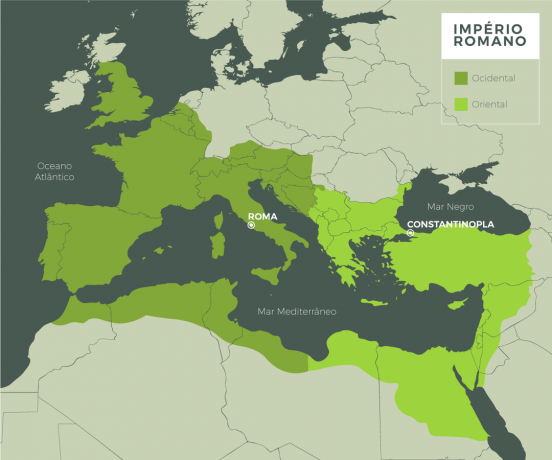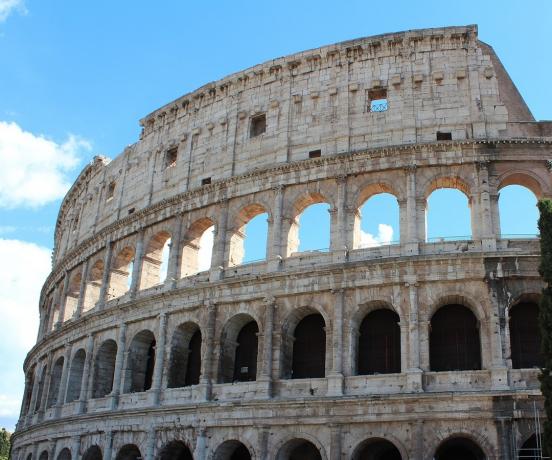The Roman Empire was a long period of the imperial phase of Roman civilization that lasted approximately 500 years (27 a. Ç. to 476 d. Ç.). Begins after the end of the Republic (509 a. Ç. to 27 a. Ç.).
An Empire is characterized by the concentration of power in the hands of a single person - the emperor - and in the Roman Empire there were more than 80 rulers. The first emperor was Octavian Augusto (of 27 a. Ç. to 19 th Ç.).
Summary of the history of the Roman Empire
The period can be divided into two major phases: o High Empire, the longest phase, which lasted from its appearance until the year 305 d. Ç. it's the low empire, from 305 d. C to 476 d. Ç.
High Empire
The Upper Empire receives this name because it was the period of growth and achievements of the Roman Empire. The emperor - supported by the Senate, which had its power reduced - controlled decisions in all sectors.
It was during the High Empire that new territories were conquered and the Empire's area of domain grew a lot. Important public works were also built, with Hadrian's Wall, which protected the domains from invasion attempts. Amphitheaters and spas are also examples of buildings from the Roman Empire.
 Hadrian's Wall currently (Northumberland/England).
Hadrian's Wall currently (Northumberland/England).
Economic growth was mainly due to commercial activities and the economic system was based mainly in the work of slaves - the peoples of the conquered territories were often enslaved by the Romans.
Another important feature of the period were power disputes, often marked by collusion and treason, which resulted in numerous changes in the leadership of the Empire.
In recent decades, the power of the Empire has begun to decline as a result of revolts in the army and rising costs of its maintenance.
The phase of the High Empire ends in the year 305 d. a., when the emperor Diocleciano leaves the government.
low empire
This phase is marked by crises that led to the decay of the Empire. The main factors that led to the crisis were the loss of power and the decline in economic growth, mainly due to the reduction in territorial conquests.
The absence of conquests of new territories gave rise to several consequences that put the Empire in balance. As the economy was based on slave labor, production and trade began to face difficulties.
Decreased tax collections further exacerbate the economic crisis, as does the difficulty in maintaining the costly Roman army.
All these problems caused the Empire to have its borders weakened, making it more vulnerable to invasions.
The year 476 d. Ç. marks the fall of the Western Roman Empire. The Eastern Roman Empire still continued for almost a thousand years, until its fall, in the year 1453.
The division of the Roman Empire
The death of Emperor Theodosius in 395 d. Ç. marks the division of the Roman Empire into two regions: Western Roman Empire and Eastern Roman Empire.
The division had already taken place before, as a solution to facilitate the political administration of the extensive territory. But it was after Theodosius' death that the division was definitive. The two parts of the Roman Empire were under the responsibility of the emperor's sons: Arcadius and Honorius.
 Territorial division between Western Roman Empire and Eastern Roman Empire.
Territorial division between Western Roman Empire and Eastern Roman Empire.
O Western Roman Empire, whose capital was Rome, was formed by many different cultures, the result of the process of conquest of new territories.
This part of the Empire does not last long and ends up divided into several small kingdoms. The Western Roman Empire ceases to exist in 476 d. a., when general Flavio Odoacro invades the region, deposes the emperor and becomes king - his reign extends from 476 d. Ç. to 496 d. Ç.
O eastern roman empire, with its capital at Constantinople and also called the Byzantine Empire - lasted longer. This part of the imperial division has faced difficulties over the years, such as wars and weakening due to internal government conflicts.
Even so, he stood out for a long time, being economically successful. The Eastern Roman Empire resists until the year 1453, when it is dominated by the Turks.
the fall of the Roman Empire
The trajectory leading to the fall of the Roman Empire begins after the division between the Western Roman Empire and the Eastern Roman Empire. The main causes were crises in politics and the economy, besides the barbarian invasions that happened in that period.
Some of the reasons that led to the fall of the Roman Empire were:
- the army's high maintenance costs;
- the growing corruption in government;
- difficulties in administering the extensive territory;
- disputes that weakened power;
- decrease in the number of slaves, due to the decrease in conquests of new territories;
- high cost of taxes levied and reduced collection;
- growth of Christianity;
- fall in production and decline in trade.
Learn more about the reasons that led to the fall of the Roman Empire.
Characteristics of the Roman Empire
The main features of the Roman Empire are:
- emperors' governments were for life: they had no fixed duration;
- the Roman Empire was polytheistic, there were beliefs in several gods;
- it was a very commerce-oriented period;
- slavery was the basis of work;
- Latin emerged during the Roman Empire;
- the coups and invasions were the way to conquer new territories,
- it was a period of territorial expansion: the Empire reached over 6,000,000 km².
Meet others features of the Roman Empire.
main emperors
The emperor was responsible for controlling the activities of the Empire, making political and economic decisions, and appointing the governors of the new territories. He was also responsible for controlling legal decisions, the Army and even religious matters.
The long period of Empire had more than 80 emperors. Some of the most important ones were:
- Octavian Augustus (27 a. Ç. to 14 d. C.): was the first emperor of Rome and ordered actions that resulted in an increase in the territory.
- Claudius (41 d. Ç. to 54 d. C.): was responsible for important territorial expansions and for the growth of the economy during his government.
- Nero (54 d. Ç. to 68 d. C.): was considered a little competent emperor in the administration. He had Christians persecuted, whom he found guilty of the fire in Rome in AD 64. Ç.
- Titus Flavio (69 d. Ç. to 79 d. C.): was responsible for the order to destroy the Temple of Solomon. The construction of the Coliseum in Rome took place during the period he ruled.
 Coliseum (Rome/Italy).
Coliseum (Rome/Italy).
- Trajan (98 d. Ç. to 117 d. C.): achieved important territorial conquests and made public works in Rome. He was quite combative and ordered a persecution of the Christian people.
- Hadrian (117 d. Ç. to 138 d. C.): in his government the Wall of Hadrian was built. The work had 120 kilometers and was built to make it difficult to invade the Roman territory.
- Diocletian (284 d. Ç. to 305 d. C.): created the diarchy and tetrarchy, the division of government administration with two or four rulers. It was during his rule that the Empire was divided into East and West.
- Constantine I (307 d. Ç. to 337 d. C.): published the Edict of Milan in 313 d. Ç. The document determined that the Empire had no official religion and ended the persecution of the Christian people.
Read more about Empire and imperialism.
